Zooxanthellae: Difference between revisions
| Line 45: | Line 45: | ||
* Relationship has lasted for more than 200 million years | * Relationship has lasted for more than 200 million years | ||
** Sugar/Carbohydrate Export | ** Sugar/Carbohydrate Export | ||
** Lipid Export | |||
** Amino Acid Export | ** Amino Acid Export | ||
Revision as of 14:28, 17 April 2013
Zooxanthellae
Physiology
Physical characteristics
Zooxanthellae are part of the group dinophyta, which are single-celled mixotrophic microorganisms.
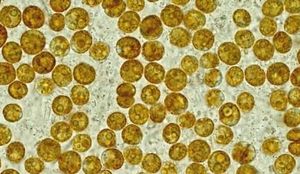
This class of organisms has two flagella, one transverse and one longitudinal. The longitudinal flagella is used as a rutter for directional steering.
The transverse flagella is used for propultion. It is two to three times the length of the longitudinal flagellum and is composed of axoneme, which causes the organelle to take on a striated form (like a ribbon). The flagella possess mastigonemes (small flagellar hairs).
Dinoflagellates use thecal plates as a method of defense against predators. Theca are armor-like plates on the exterior of the cell that are composed of cellulose. Note: individuals may not have thecal plates at all stages of their life cycle.
Genetic characteristics
The genetic load of a dinoflagellate is unique to members of this group. Within the nucleus, the DNA is not organized into nucleosomes, and histone
proteins are absent. However, the chromosomes are always condensed. Remarkably, the genome size ranges from 3,000 to 215,000 Mbps. Comparably, the entire human genome
is closer to the 3,000 Mbp mark. While the majority of the dinophyta genome is non-coding, it is thought to have a structural function.
Zooxanthellae is the name given to a wide array of different algae of the genus Symbiodinium. This specific clade is primarily found in symbiotic
relationships.
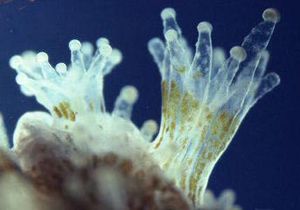
Behavior
- Under-represented in the water column
- live in the tissues of other organisms
- Cnidarians (Coral Polyps, Jellyfish, Sea Anemone)
- Nudibranchs (Sea Slugs)
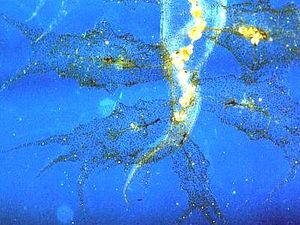
Mutualistic Relationship with Coral Reefs
- Photosynthesis
- Corals provide a safe environment and compounds needed for photosynthesis
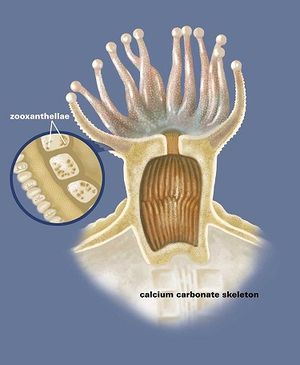
- Zooxanthellae provide food (nutrients) for the coral to use in order to secrete calcium carbonate skeleton
- Highly efficient exchange of nutrients
- Relationship has lasted for more than 200 million years
- Sugar/Carbohydrate Export
- Lipid Export
- Amino Acid Export
Environmental Impact & Coral Bleaching
Bleaching occurs when environmental stress adversely affects the mutually beneficial relationship between the host organism and its zooxanthellae. Several factors can cause the zooxanthellae to be expelled from the coral polyp. The coral then loses all pigment (as the polyp is naturally clear).
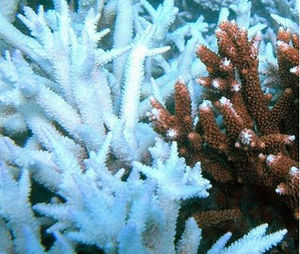
Sources
http://oceanservice.noaa.gov/education/kits/corals/coral02_zooxanthellae.html (accessed on 2/23/13)
http://coralreef.noaa.gov/aboutcorals/coral101/symbioticalgae/ (accessed on 2/23/13)
http://www.biolbull.org/content/137/3/506.short
http://www.int-res.com/articles/meps/71/m071p065.pdf
http://www.int-res.com/articles/meps/180/m180p139.pdf
http://link.springer.com/article/10.1007%2FBF00348077?LI=true
Picture Sources
1. http://www.seaslugforum.net/